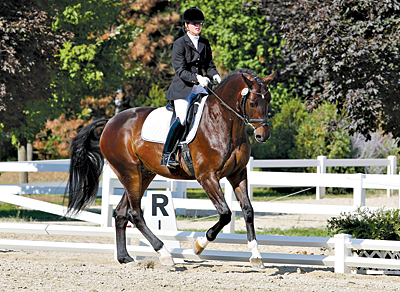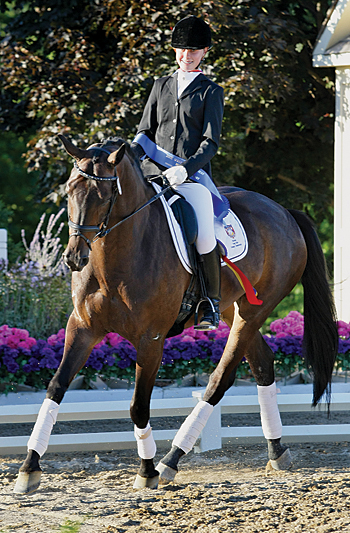She pushes through physical trauma and personal upheaval to demonstrate her superior equitation.
Colleen Akin decided to become the best dressage rider she could be, and despite injury and personal sacrifice, she’s well on her way this year with a win in the USEF Dressage Seat Medal Finals in the 14-18 division.
 Akin, 17, placed second two years ago in the Finals, and she determined she’d try to come back and win. But last year she didn’t qualify at her regional finals, so she had to sit on the sidelines even though the show was held at her home showgrounds in New York. In fact, Akin offered her horse Duet to another competitor, as riders come from all over the country for the Finals and often borrow a local mount.
Akin, 17, placed second two years ago in the Finals, and she determined she’d try to come back and win. But last year she didn’t qualify at her regional finals, so she had to sit on the sidelines even though the show was held at her home showgrounds in New York. In fact, Akin offered her horse Duet to another competitor, as riders come from all over the country for the Finals and often borrow a local mount.
Akin almost missed her chance again this year at the Dressage At Lamplight show, held Aug. 29-31 in Wayne, Ill.
She finished third in her regional championships, and only the top two are invited to the Finals. But when one rider declined to go, Akin made the most of the opportunity by coming home victorious.
“I’ve always thought that equitation was really important,” said Akin. “I started off doing the hunters and New England Pinto Association shows. I think a lot of dressage riders only think about the horses and forget about themselves. It’s important to try to get yourself as good as you can be so you can give the horse a fair opportunity.”
But it hasn’t been an easy road for Akin. Two years ago she suffered a devastating fall while jumping a horse. The mare stepped on her arm, kicked her in the face and landed on her back.
“I got [chiropractic work] all last year, and I just got a new doctor, who does some chiropractic and physical therapy. He did miracles for me before I went to the Finals so I wasn’t in pain,” said Akin. “On and off I’ve had really bad back spasms.
It’s better now, and this year it finally feels better. I’ve done a lot of work with Eckart Meyners for the past few years. I run a lot and go to the gym to build up my core strength.”
Akin’s fall isn’t the only difficulty she’s had to overcome. A resident of Warwick, N.Y., Akin moved to Southington, Conn., to live with her aunt so she could continue her dressage training with Vicki Hammers-O’Neil and Lendon Gray.
“It was hard when I first moved here, but I wasn’t with Vicki at the time, and I wasn’t living with my aunt,” said Akin. “Now that I’m in school again—I was home schooled for a little while—I have kind of a social life again, and I’m best friends with Vicki’s daughter now.”
Akin prepared for the Medal Finals by memorizing all the first level tests and practicing the movements, so she’d be ready for any test the judges set. “I did exercises every night, and I tried to figure out a good stretching system before I went to the Finals. I always listen to my iPod to get focused on the day of a big show. I was warming up like Michael Phelps and stretching like him. Everyone was making fun of me,” said Akin.
Because the Finals were in Illinois, Akin borrowed Volontaire, a 6-year-old Dutch Warmblood (Concorde—Awoda) from Kim Barteau. “He was the fanciest horse I’ve ever sat on,” she said. “The Barteaus donated almost all of the horses in both divisions. I think they were amazing throughout the whole thing. Their entire staff was incredible. They were competing 10-15 times per day and were still helping us.”
ADVERTISEMENT
Akin placed third in the warm-up (75.00%) but was able to really show off with the more difficult test in the Final. Competitors had to start trotting at C, turn across the middle of the ring, turn onto a 20-meter circle left at X, pick up canter in the first quarter of the circle, do a simple change of lead through the trot at X, canter a 20-meter circle right, trot before X and halt at X.
| She’s Just Darlin’
Diamond Darling may have an unusual name for a dressage horse, but Heather McCarthy said the sweet mare has more than earned it. “She’s just darling. She’s the quietest, most pleasurable horse to work around,” said McCarthy. McCarthy rode the 11-year-old Hanoverian (Davignon—Raphaela) to three wins at the Dressage At Lamplight August show, taking home two fourth level blues and a Prix St. Georges win. Diamond Darling’s owner, Paulette Perry, also secured two wins in amateur third level classes. “I’ve known ‘Diamond’ since she was 4,” said McCarthy. “My old trainer, Wendy Sanders, worked with her and Paulette when she was a baby. Two years ago I started taking over the training on her. She’s a good soul, she’s quiet, and she and Paulette are a perfect pair.” When McCarthy moved Diamond up to fourth level, she was concerned because her pirouettes were weak, but she said they were scoring 8s by the end of the season. McCarthy’s best score came in their fourth level, test 3, class (63.90%). “It’s a good test for her with the shoulder-in on the centerline because she’s so straight and connected,” said McCarthy. “There are so many changes in the Prix St. Georges that she was a little tired.” McCarthy, 24, started her own training business six years ago in Hampshire, Ill., and spends her days traveling between a few barns to teach her clients and ride. “I’ve known Paulette since I was 10 years old,” said McCarthy. “My old trainer stopped training and moved out of state. When that happened Paulette switched to me. I think Diamond will definitely do Prix St. Georges and I1 next year. Paulette would love to see me do an FEI-level musical freestyle with her. Then she’ll be Paulette’s teacher. I’d love to see Paulette ride at the FEI levels.” |
“They had one judge facing you, one judge behind you and one at C, so you couldn’t get away with anything,” said Akin. “The judges told me I did a good job half-halting, and I really rode with my seat.” Her score of 76.66 percent was enough to earn her the blue.
Upon returning home, Akin discovered that riding Volontaire had helped her with her own mare. “I learned so much from that horse,” she said. “I was riding my own horse better because I was having my butt kicked by this big, strong horse.”
They Were Rooting For Each Other
Akin didn’t have as much chance to socialize as she would’ve liked this year, but she did meet and cheer for Stephanie Early, who was staying in the same hotel and competing in the 13 and under division of the Finals.
“It was really fun to meet different girls from across the country who love horses and do the same stuff,” said Early. “I was really nervous, but it was much more fun than I expected.”
ADVERTISEMENT
One of the reasons it turned out to be so much fun for Early was that she won the warm-up class (80.00%) and the Final (80.33%).
Early didn’t even plan on attending the Medal Finals this year. Like Akin, she’d placed third at her regional qualifier. But when the first- and second-placed riders were disqualified because they were too old, Early received the chance to show off her skills.
Early flew out from Salinas, Calif., with her trainer, Jennifer Roth, and also borrowed a horse from the Barteaus, Gina Franz’s Sarasanna GP, a 6-year-old Hanoverian (Sandro Hit—Rionda).
“She was so much fun and gorgeous,” said Early. “She’s much bigger than any of the horses I’ve ever ridden, and she has a bigger gait. I rode Sara on Wednesday morning [before the show]. I could hardly get her to trot from the canter. It was hard to sit because she has such big movement. But by Friday I totally loved Sara, and now I miss her.”
Early felt more confident about her first day of competition than the final test. The younger division had to perform a three-loop serpentine in the sitting trot for the warm-up, and for the final test they rode a 20-meter circle, halted at X, and then did another 20-meter circle in the opposite direction.
“When I did the 20-meter circles on Saturday, I didn’t make it all the way to X,” said Early. “I was a little off, and I thought I’d totally screwed it up. I felt that I rode much better on Friday, and I got more of a chance to spread out from the other riders [in the group portion of the competition]. On Saturday everyone was pumped up and doing their best, and it was a lot harder.”
 But despite Early’s doubts, the judges complimented her quiet, lovely seat and expressed high hopes for her future.
But despite Early’s doubts, the judges complimented her quiet, lovely seat and expressed high hopes for her future.
Early received her first pony at age 7. She started competing in hunter/jumper classes and always enjoyed the equitation classes. So when she began to focus on dressage, it seemed like a natural progression to try dressage seat equitation.
“I had a ton of longe lessons,” said Early. “My trainer had me get on other horses so I could get used to having the same position on any horse. It was fun, but it was pretty hard.”
What made the experience even more difficult was that she was taking the place of one of her best friends, Madeline Hays. Hays won the equitation class at the regional finals but discovered later that she should’ve been competing in the 14-18 division, since her 14th birthday occurred in 2007.
“Maddie was really nice, and she didn’t say anything, but that was awkward,” said Early, who just turned 14. Fortunately, Hays and Early’s other best friend, Leah Myers, had their chance to take home championships at the California Dressage Society Northern Junior/Young Rider Championships in August.
“It’s horrible competing against my best friends. I hate it,” admitted Early. So she’s hoping that in the next few years, the three of them can represent Region 7 at the North American Junior And Young Rider Championships as a team.
Sara Lieser














